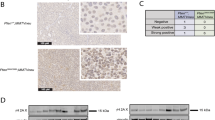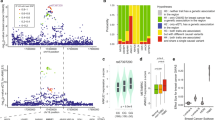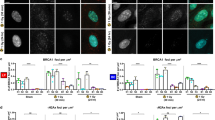Abstract
The tyrosine kinase WEE1 controls the timing of entry into mitosis in eukaryotes and its genetic deletion leads to pre-implantation lethality in mice. Here, we show that besides the premature mitotic entry phenotype, Wee1 mutant murine cells fail to complete mitosis properly and exhibit several additional defects that contribute to the deregulation of mitosis, allowing mutant cells to progress through mitosis at the expense of genomic integrity. WEE1 interacts with the anaphase promoting complex, functioning as a negative regulator, and the deletion of Wee1 results in hyper-activation of this complex. Mammary specific knockout mice overcome the DNA damage response pathway triggered by the mis-coordination of the cell cycle in mammary epithelial cells and heterozygote mice spontaneously develop mammary tumors. Thus, WEE1 functions as a haploinsufficient tumor suppressor that coordinates distinct cell division events to allow correct segregation of genetic information into daughter cells and maintain genome integrity.
This is a preview of subscription content, access via your institution
Access options
Subscribe to this journal
Receive 50 print issues and online access
We are sorry, but there is no personal subscription option available for your country.
Buy this article
- Purchase on SpringerLink
- Instant access to full article PDF
Prices may be subject to local taxes which are calculated during checkout







Similar content being viewed by others
References
Nurse P . Genetic control of cell size at cell division in yeast. Nature 1975; 256: 547–551.
Thuriaux P, Nurse P, Carter B . Mutants altered in the control co-ordinating cell division with cell growth in the fission yeast Schizosaccharomyces pombe. Mol Gen Genet 1978; 161: 215–220.
Fantes PA, Nurse P . Control of the timing of cell division in fission yeast. Cell size mutants reveal a second control pathway. Exp Cell Res 1978; 115: 317–329.
Squire CJ, Dickson JM, Ivanovic I, Baker EN . Structure and inhibition of the human cell cycle checkpoint kinase, Wee1A kinase: an atypical tyrosine kinase with a key role in CDK1 regulation. Structure 2005; 13: 541–550.
Featherstone C, Russell P . Fission yeast p107wee1 mitotic inhibitor is a tyrosine/serine kinase. Nature 1991; 349: 808–811.
Gould KL, Nurse P . Tyrosine phosphorylation of the fission yeast cdc2+ protein kinase regulates entry into mitosis. Nature 1989; 342: 39–45.
Lundgren K, Walworth N, Booher R, Dembski M, Kirschner M, Beach D . mik1 and wee1 cooperate in the inhibitory tyrosine phosphorylation of cdc2. Cell 1991; 64: 1111–1122.
Parker LL, Atherton-Fessler S, Piwnica-Worms H . p107wee1 is a dual-specificity kinase that phosphorylates p34cdc2 on tyrosine 15. Proc Natl Acad Sci USA 1992; 89: 2917–2921.
Parker LL, Piwnica-Worms H . Inactivation of the p34cdc2-cyclin B complex by the human WEE1 tyrosine kinase. Science 1992; 257: 1955–1957.
Parker LL, Sylvestre PJ, Byrnes MJ 3rd, Liu F, Piwnica-Worms H . Identification of a 95-kDa WEE1-like tyrosine kinase in HeLa cells. Proc Natl Acad Sci USA 1995; 92: 9638–9642.
Dunphy WG, Kumagai A . The cdc25 protein contains an intrinsic phosphatase activity. Cell 1991; 67: 189–196.
Gautier J, Solomon MJ, Booher RN, Bazan JF, Kirschner MW . cdc25 is a specific tyrosine phosphatase that directly activates p34cdc2. Cell 1991; 67: 197–211.
Kumagai A, Dunphy WG . The cdc25 protein controls tyrosine dephosphorylation of the cdc2 protein in a cell-free system. Cell 1991; 64: 903–914.
Millar JB, McGowan CH, Lenaers G, Jones R, Russell P . p80cdc25 mitotic inducer is the tyrosine phosphatase that activates p34cdc2 kinase in fission yeast. EMBO J 1991; 10: 4301–4309.
Strausfeld U, Labbe JC, Fesquet D, Cavadore JC, Picard A, Sadhu K et al. Dephosphorylation and activation of a p34cdc2/cyclin B complex in vitro by human CDC25 protein. Nature 1991; 351: 242–245.
Stumpff J, Kellogg DR, Krohne KA, Su TT . Drosophila Wee1 interacts with members of the gammaTURC and is required for proper mitotic-spindle morphogenesis and positioning. Curr Biol 2005; 15: 1525–1534.
Deng CX . BRCA1: cell cycle checkpoint, genetic instability, DNA damage response and cancer evolution. Nucleic Acids Res 2006; 34: 1416–1426.
Negrini S, Gorgoulis VG, Halazonetis TD . Genomic instability-an evolving hallmark of cancer. Nat Rev Mol Cell Biol 2010; 11: 220–228.
Bartkova J, Rezaei N, Liontos M, Karakaidos P, Kletsas D, Issaeva N et al. Oncogene-induced senescence is part of the tumorigenesis barrier imposed by DNA damage checkpoints. Nature 2006; 444: 633–637.
Kastan MB, Bartek J . Cell-cycle checkpoints and cancer. Nature 2004; 432: 316–323.
Lukas J, Lukas C, Bartek J . Mammalian cell cycle checkpoints: signalling pathways and their organization in space and time. DNA Repair (Amst) 2004; 3: 997–1007.
Indovina P, Marcelli E, Di Marzo D, Casini N, Forte IM, Giorgi F et al. Abrogating G /M checkpoint through WEE1 inhibition in combination with chemotherapy as a promising therapeutic approach for mesothelioma. Cancer Biol Ther 2013; 15: 380–388.
Simanski S, Madoux F, Rahaim RJ, Chase P, Schurer S, Cameron M et al. Identification of Small Molecule Inhibitors of Wee1 Degradation and Mitotic Entry. Probe Reports from the NIH Molecular Libraries Program: NIH, Bethesda, MD, USA, 2010.
Towler WI, Zhang J, Ransburgh DJ, Toland AE, Ishioka C, Chiba N et al. Analysis of BRCA1 variants in double-strand break repair by homologous recombination and single-strand annealing. Hum Mutat 2013; 34: 439–445.
Hollstein M, Sidransky D, Vogelstein B, Harris CC . p53 mutations in human cancers. Science 1991; 253: 49–53.
Michael D, Oren M . The p53 and Mdm2 families in cancer. Curr Opin Genet Dev 2002; 12: 53–59.
Dixon H, Norbury CJ . Therapeutic exploitation of checkpoint defects in cancer cells lacking p53 function. Cell Cycle 2002; 1: 362–368.
Bucher N, Britten CD . G2 checkpoint abrogation and checkpoint kinase-1 _targeting in the treatment of cancer. Br J Cancer 2008; 98: 523–528.
Kawabe T . G2 checkpoint abrogators as anticancer drugs. Mol Cancer Ther 2004; 3: 513–519.
Peters JM . The anaphase promoting complex/cyclosome: a machine designed to destroy. Nat Rev Mol Cell Biol 2006; 7: 644–656.
Pines J . The APC/C: a smorgasbord for proteolysis. Mol Cell 2009; 34: 135–136.
Li M, Zhang P . The function of APC/CCdh1 in cell cycle and beyond. Cell Div 2009; 4: 2.
Pines J . Mitosis: a matter of getting rid of the right protein at the right time. Trends Cell Biol 2006; 16: 55–63.
Garcia-Higuera I, Manchado E, Dubus P, Canamero M, Mendez J, Moreno S et al. Genomic stability and tumour suppression by the APC/C cofactor Cdh1. Nat Cell Biol 2008; 10: 802–811.
Kim HS, Vassilopoulos A, Wang RH, Lahusen T, Xiao Z, Xu X et al. SIRT2 maintains genome integrity and suppresses tumorigenesis through regulating APC/C activity. Cancer Cell 2011; 20: 487–499.
Saeki T, Ouchi M, Ouchi T . Physiological and oncogenic Aurora-A pathway. Int J Biol Sci 2009; 5: 758–762.
Schmit TL, Zhong W, Nihal M, Ahmad N . Polo-like kinase 1 (Plk1) in non-melanoma skin cancers. Cell Cycle 2009; 8: 2697–2702.
Tominaga Y, Li C, Wang RH, Deng CX . Murine Wee1 plays a critical role in cell cycle regulation and pre-implantation stages of embryonic development. Int J Biol Sci 2006; 2: 161–170.
Heald R, McLoughlin M, McKeon F . Human wee1 maintains mitotic timing by protecting the nucleus from cytoplasmically activated Cdc2 kinase. Cell 1993; 74: 463–474.
Timofeev O, Cizmecioglu O, Settele F, Kempf T, Hoffmann I . Cdc25 phosphatases are required for timely assembly of CDK1-cyclin B at the G2/M transition. J Biol Chem 2010; 285: 16978–16990.
Trovesi C, Falcettoni M, Lucchini G, Clerici M, Longhese MP . Distinct Cdk1 requirements during single-strand annealing, noncrossover, and crossover recombination. PLoS Genet 2011; 7: e1002263.
Engelbert D, Schnerch D, Baumgarten A, Wasch R . The ubiquitin ligase APC(Cdh1) is required to maintain genome integrity in primary human cells. Oncogene 2008; 27: 907–917.
DePinho RA . The age of cancer. Nature 2000; 408: 248–254.
Murray AW, Solomon MJ, Kirschner MW . The role of cyclin synthesis and degradation in the control of maturation promoting factor activity. Nature 1989; 339: 280–286.
Lianga N, Williams EC, Kennedy EK, Dore C, Pilon S, Girard SL et al. A Wee1 checkpoint inhibits anaphase onset. J Cell Biol 2013; 201: 843–862.
Harvey SL, Charlet A, Haas W, Gygi SP, Kellogg DR . Cdk1-dependent regulation of the mitotic inhibitor Wee1. Cell 2005; 122: 407–420.
Simpson-Lavy KJ, Brandeis M . Clb2 and the APC/C(Cdh1) regulate Swe1 stability. Cell Cycle 2010; 9: 3046–3053.
van Vugt MA, Bras A, Medema RH . Polo-like kinase-1 controls recovery from a G2 DNA damage-induced arrest in mammalian cells. Mol Cell 2004; 15: 799–811.
Rajeshkumar NV, De Oliveira E, Ottenhof N, Watters J, Brooks D, Demuth T et al. MK-1775, a potent Wee1 inhibitor, synergizes with gemcitabine to achieve tumor regressions, selectively in p53-deficient pancreatic cancer xenografts. Clin Cancer Res 2011; 17: 2799–2806.
Hirai H, Arai T, Okada M, Nishibata T, Kobayashi M, Sakai N et al. MK-1775, a small molecule Wee1 inhibitor, enhances anti-tumor efficacy of various DNA-damaging agents, including 5-fluorouracil. Cancer Biol Ther 2010; 9: 514–522.
Hirai H, Iwasawa Y, Okada M, Arai T, Nishibata T, Kobayashi M et al. Small-molecule inhibition of Wee1 kinase by MK-1775 selectively sensitizes p53-deficient tumor cells to DNA-damaging agents. Mol Cancer Ther 2009; 8: 2992–3000.
Wang Y, Decker SJ, Sebolt-Leopold J . Knockdown of Chk1, Wee1 and Myt1 by RNA interference abrogates G2 checkpoint and induces apoptosis. Cancer Biol Ther 2004; 3: 305–313.
Posthumadeboer J, Wurdinger T, Graat HC, van Beusechem VW, Helder MN, van Royen BJ et al. WEE1 inhibition sensitizes osteosarcoma to radiotherapy. BMC Cancer 2011; 11: 156.
Wang Y, Li J, Booher RN, Kraker A, Lawrence T, Leopold WR et al. Radiosensitization of p53 mutant cells by PD0166285, a novel G(2) checkpoint abrogator. Cancer Res 2001; 61: 8211–8217.
Iorns E, Lord CJ, Grigoriadis A, McDonald S, Fenwick K, Mackay A et al. Integrated functional, gene expression and genomic analysis for the identification of cancer _targets. PLoS ONE 2009; 4: e5120.
Mir SE, De Witt Hamer PC, Krawczyk PM, Balaj L, Claes A, Niers JM et al. In silico analysis of kinase expression identifies WEE1 as a gatekeeper against mitotic catastrophe in glioblastoma. Cancer Cell 2010; 18: 244–257.
Dine J, Deng CX . Mouse models of BRCA1 and their application to breast cancer research. Cancer Metastasis Rev 2013; 32: 25–37.
Robinson GW, Hennighausen L . MMTV-Cre transgenes can adversely affect lactation: considerations for conditional gene deletion in mammary tissue. Anal Biochem 2011; 412: 92–95.
Wagner KU, Wall RJ, St-Onge L, Gruss P, Wynshaw-Boris A, Garrett L et al. Cre-mediated gene deletion in the mammary gland. Nucleic Acids Res 1997; 25: 4323–4330.
Hayashi S, McMahon AP . Efficient recombination in diverse tissues by a tamoxifen-inducible form of Cre: a tool for temporally regulated gene activation/inactivation in the mouse. Dev Biol 2002; 244: 305–318.
Acknowledgements
We are grateful for the critical reading and helpful discussion of members of the Deng laboratory. This work was supported in part by the Intramural Research Program of the NIDDK, NCI and CCR, NIH. DG is supported by 1R01CA152601-01 from the NCI, BC093803 from the DOD, SPORE P50CA98131 and a Hirshberg Foundation for Pancreatic Cancer Research Seed Grant Award. Melissa Stauffer, PhD, of Scientific Editing Solutions, provided editorial assistance.
Author information
Authors and Affiliations
Corresponding author
Ethics declarations
Competing interests
The authors declare no conflict of interest.
Additional information
Supplementary Information accompanies this paper on the Oncogene website
Supplementary information
Rights and permissions
About this article
Cite this article
Vassilopoulos, A., Tominaga, Y., Kim, HS. et al. WEE1 murine deficiency induces hyper-activation of APC/C and results in genomic instability and carcinogenesis. Oncogene 34, 3023–3035 (2015). https://doi.org/10.1038/onc.2014.239
Received:
Revised:
Accepted:
Published:
Issue Date:
DOI: https://doi.org/10.1038/onc.2014.239
This article is cited by
-
The RepID–CRL4 ubiquitin ligase complex regulates metaphase to anaphase transition via BUB3 degradation
Nature Communications (2020)
-
WEE1 inhibition _targets cell cycle checkpoints for triple negative breast cancers to overcome cisplatin resistance
Scientific Reports (2017)
-
Cell cycle proteins as promising _targets in cancer therapy
Nature Reviews Cancer (2017)
-
Suppression of Sirt1 sensitizes lung cancer cells to WEE1 inhibitor MK-1775-induced DNA damage and apoptosis
Oncogene (2017)



